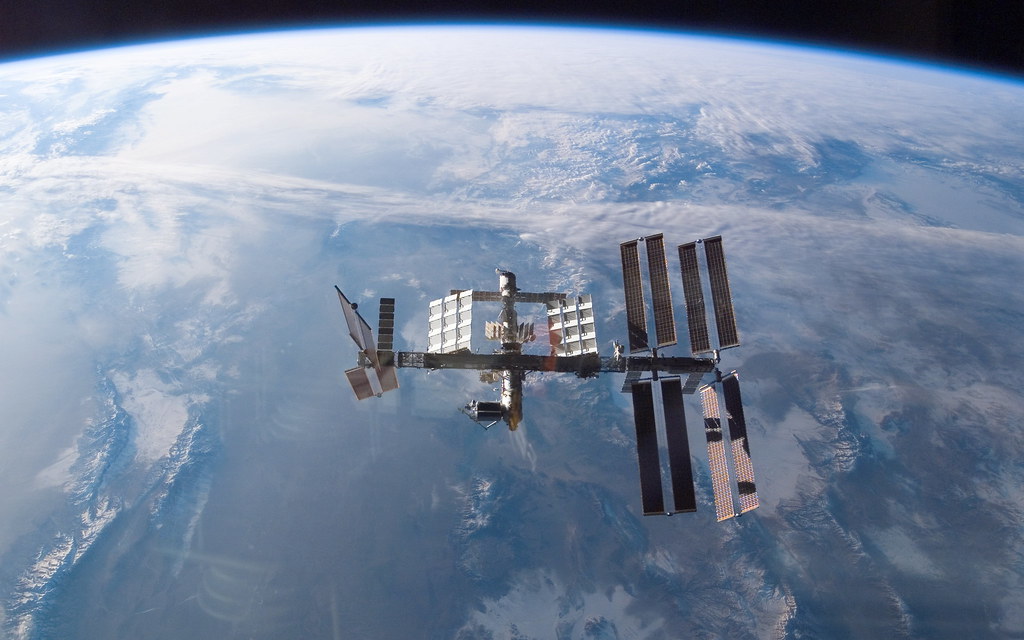Photo by STS-122 Shuttle Crew / NASA
WASHINGTON — The Star Wars soundtrack blasted out of the speaker system as yellow words faded into a starry landscape on the projector. “Commercial: the new future of space” rolled across the screen.
At the 15th annual Federal Aviation Administration’s Commercial Space and Transportation Conference, presenters Wednesday spoke of a future that is closer than we think.
A short video before the program compared mockups of real spaceships to science fiction movies. A “Star Trek” space station faded into the International Space Station and a “Star Wars” cruiser faded into a mockup of a space ship designed by SpaceX – a company developing passenger space ships.
“We are at the threshold of the golden age in space flight,” said George Nield, the FAA administrator for commercial space transportation. “It is the people in this room that can make that happen.”
NASA’s $17.7 billion proposed 2013 budget is down slightly from this year’s spending. That drop-off combined with the end of the space shuttle program means the U.S. is no longer sending astronauts into orbit with its own equipment. Paying $60 million per passenger on Russian ships is not cheap, so NASA and the FAA are looking towards the private sector.
In his keynote speech, William Gerstenmair, a NASA associate administrator, said space flight is transitioning. NASA is moving from developing space vehicles to needing commercial services, he said.
“Any one of us as an individual company or government agency cannot accomplish what we are about to go do,” he said.
Currently, the core of the commercial space flight industry is the International Space Station. Right now, NASA and the FAA have cleared private ships to carry cargo to the station, which is orbiting 200 miles above Earth’s surface. Over the next eight years, private companies will operate nearly a third of flights planned to the station.
Gerstenmair believes that the Space Station will provide an opportunity for private companies to pursue space flight and research.
“The Space Station is driving a huge market,” he said. NASA and the U.S. government have provided incentives for companies to pursue space technology but real profits would take a long time to reach. The European Space Agency says it costs about $600 million for each cargo ship mission not including the $2 billion development costs.
President Barack Obama’s proposed budget for NASA and the agency’s emphasis on commercial enterprise have been met with some opposition. In an article on space.com, Rep. Adam Schiff, D-Calif., said the budget would bring deep space exploration “sadly out of reach.”
“Every trip that we make unlocks new and exciting possibilities that could be closed off with these cuts,” Schiff said.
Gerstenmair said the potential research opportunities from the Space Station provide a tangible incentive for private companies. “Now, there is a pull to go to space instead of NASA and the government pushing [companies] to go.”
Pharmaceutical companies are just one of many that would benefit from research at the station. Scientists have already used the Space Station to create a strand of salmonella that can be used as a vaccine.
Virginia Gov. Robert McDonnell said the private space industry will create an economic boom for his state and the country. It already has created 29,000 jobs and brought $7.6 billion to the state, he said. The Mid-Atlantic Regional Spaceport located in Chincoteague, Va., is one of four facilities in the U.S. with FAA clearance to launch ships to the International Space Station.
“There are very few opportunities like the space industry that promote economic expansion,” McDonnell said. “The commercial spaceflight industry has potential to grow tremendously.”
A full-color Virgin Galactic ad on the back of the conference program touts this belief with a soaring spaceship flying into a sunrise. Underneath in white letters, the ad announces, “Your journey to space begins here.”


